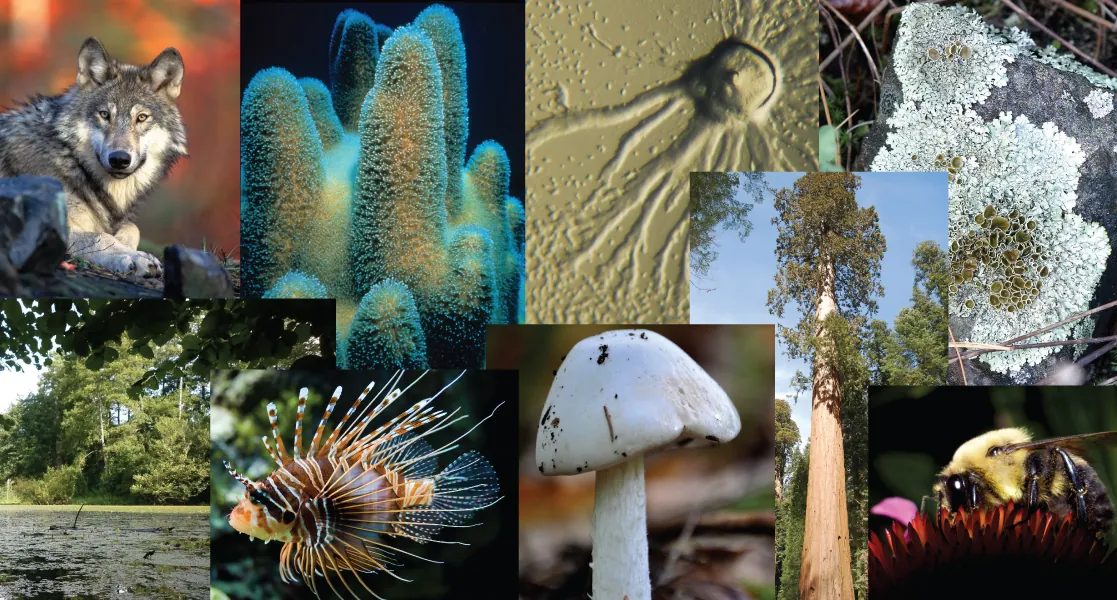19 Evolution of Populations – Preparation
All life on Earth is related. Evolutionary theory states that humans, beetles, plants, and bacteria all share a common ancestor, but that millions of years of evolution have shaped each of these organisms into the forms we see today. Scientists consider evolution a key concept to understanding life. Natural selection acts to promote traits and behaviors that increase an organism’s chances of survival and reproduction, while eliminating those traits and behaviors that are detrimental to the organism. However, natural selection can only, as its name implies, select—it cannot create. We can attribute novel traits and behaviors to another evolutionary force—mutation. Mutation and other sources of variation among individuals, as well as the evolutionary forces that act upon them, alter populations and species. This combination of processes has led to the world of life we see today.

Preparation for what you are about to learn
To better understand the concepts of natural selection, adaptation, evolution of populations and speciation, it is important that you make sure you understand some of the concepts that you have learned in General Biology 1. These are the concepts of:
- Mitosis
- Meiosis
- Heredity
If you are well-familiar with these concepts you are welcome to skip this section and move on to the next page. This will bring you to this week’s pre-lecture assignment with questions about mitosis, meiosis and heredity to prepare you for what is about to come. However, a quick refresher might help you!
Mitosis
Mitosis, also called karyogenesis or nuclear division, is discussed in Chapter 10: Cell Reproduction of OpenStax Biology 2nd Edition
Link to Learning
Mitosis
This video by Crash Course recaps the concept of mitosis. It goes into more detail than what is needed for your understanding of the following sections. However, you’re advised to at least watch the first three minutes.
Table of Contents
- Mitosis 0:24
- Interphase 3:27
- Chromatin 3:37
- Centrosomes 3:52
- Prophase 4:14
- Chromosomes 4:18
- Chromatid 4:31
- Microtubules 5:07
- Metaphase 5:22
- Motor Proteins 5:36
- Biolography 6:13
- Anaphase 9:00
- Telophase 9:15
- Cleavage 9:25
- Cytokinesis 9:36
Meiosis
Cells that are part of the sexual reproductive cycle are produced by a different type of cell division called meiosis. Meiosis is discussed in Chapter 11: Meiosis and Sexual Reproduction of OpenStax Biology 2nd Edition
Link to Learning
Meiosis
This video by Crash Course recaps the concept of meiosis. It goes into more detail than what is needed for your understanding of the following sections. However, you’re advised to at least watch the first seven minutes.
Table of Contents
- Homologous Chromosome Pairs 2:10
- Primary Oocytes 3:30
- Primary Spermatocytes 3:30
- Meiosis 2:59
- Interphase I 4:04
- Prophase I 4:37
- Crossover 5:05
- Recombination 5:05
- Metaphase I 7:53
- Anaphase I 8:05
- Telophase I 8:19
- Prophase II 8:57
- Metaphase II 9:23
- Anaphase II 9:28
- Telophase II 9:32
Heredity
Genetic information is heritable. There are a lot of biological terms related to this concept that have been discussed in General Biology 1 and it is important for the information that is about to come, that you know what these terms mean:
- alleles
- dominant and recessive
- haploid and diploid
- gametes and somatic cells
- genotype
- heterozygous and homozygous
- phenotype
You might also want to refresh your memory about Punnett squares and Mendelian genetics. Heredity is discussed in detail in Chapter 12: Mendel’s Experiments and the Laws of Probability of OpenStax Biology 2nd Edition
Link to Learning
Heredity
This video by Crash Course recaps the concept of heredity.
reproduction of individuals with favorable genetic traits that survive environmental change because of those traits, leading to evolutionary change
variation in the nucleotide sequence of a genome
genetic differences among individuals in a population
(also, karyokinesis) period of the cell cycle during which the duplicated chromosomes are separated into identical nuclei; includes prophase, prometaphase, metaphase, anaphase, and telophase
a nuclear division process that results in four haploid cells

